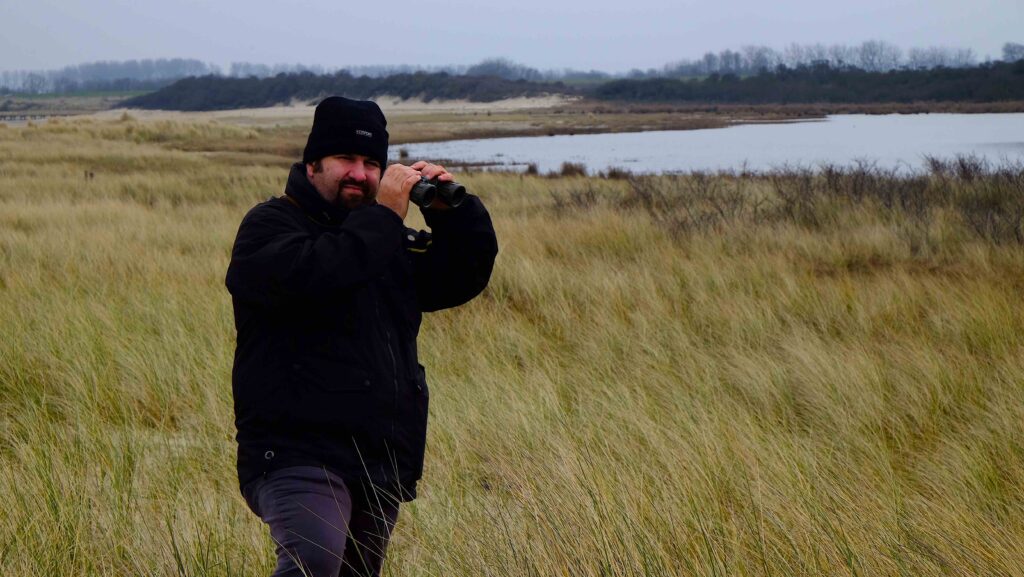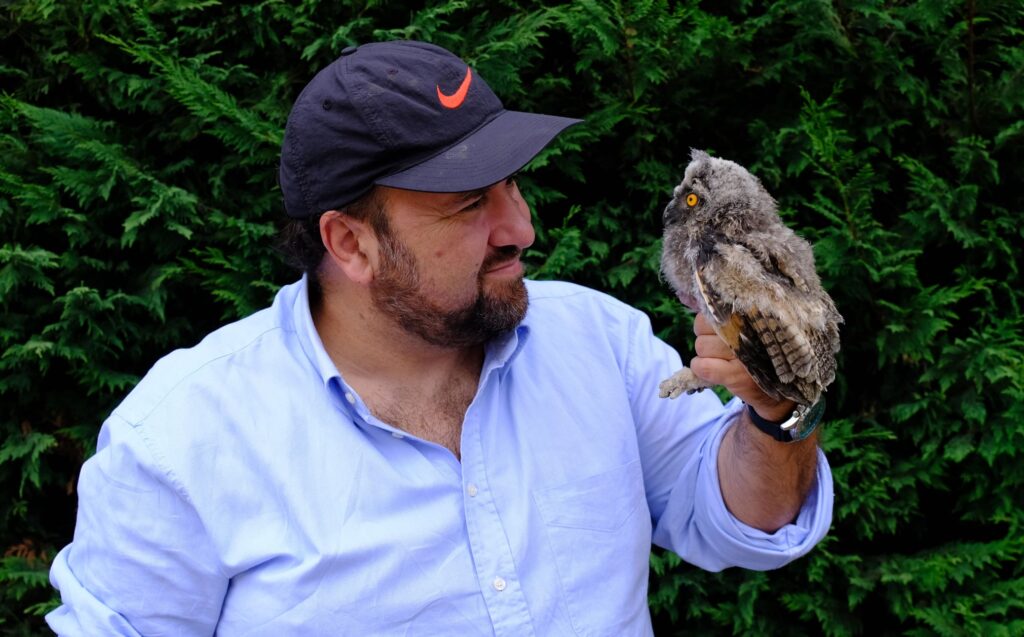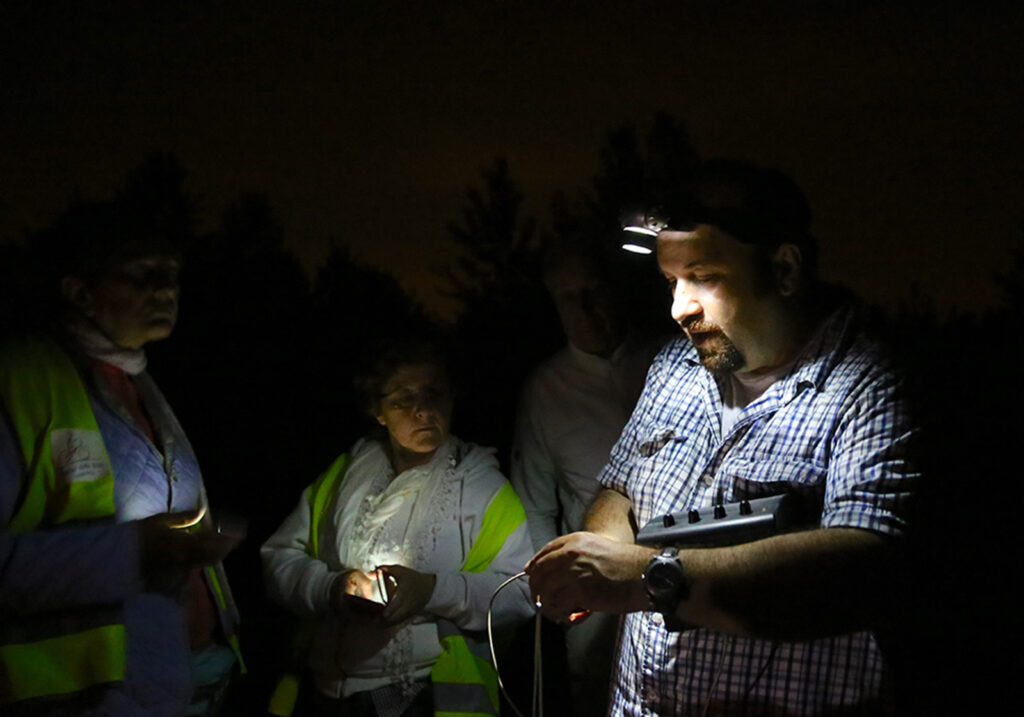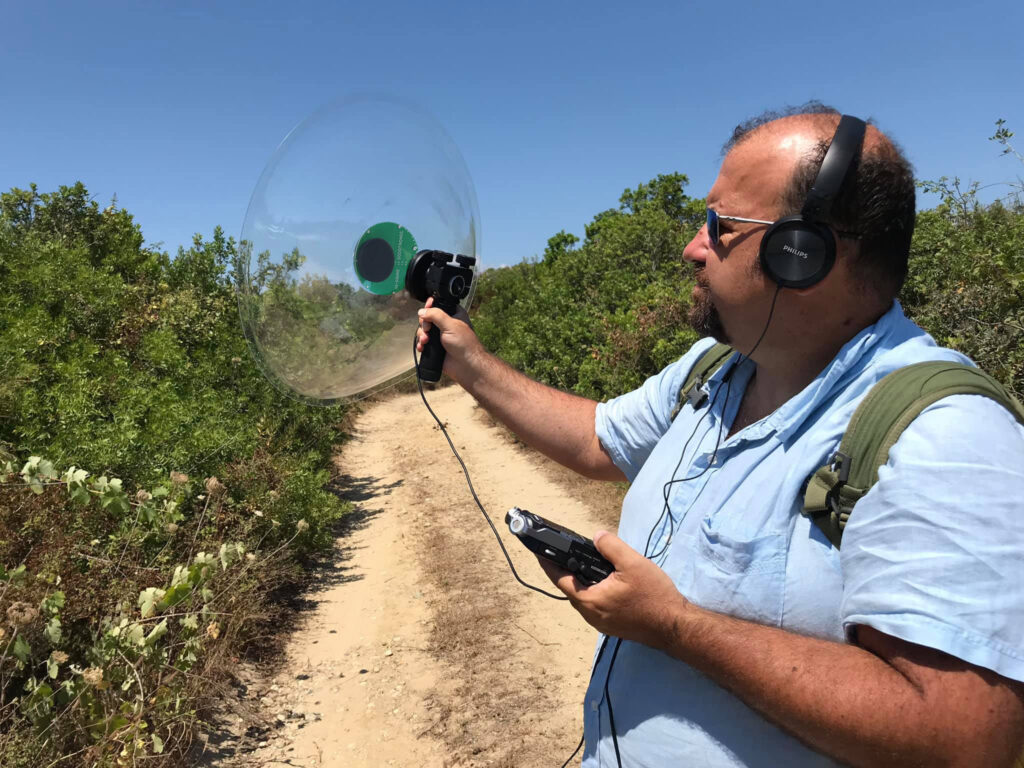MARCO MASTRORILLI
Reading Time: 7 minutes
Nato a Milano il 29 dicembre 1967 è uno scrittore, ornitologo e guida ambientale escursionistica, specializzato nella ricerca e studio dell’ecologia dei rapaci notturni.
Nel 2015 in Minnesota è stato insignito dal Global Owl Project del premio come miglior esperto di gufi a livello mondiale per quell’anno ed è entrato a far parte della prestigiosa World Owl Hall of Fame.
Ha scritto e pubblicato 24 libri (alcuni in fase di traduzione all’estero) con 12 editori diversi. Ha vinto diversi premi letterari internazionali ed è autore di centinaia di articoli divulgativi su magazine e giornali italiani e stranieri e vanta oltre 50 articoli scientifici. Ospite in molte trasmissioni radiofoniche e televisive (Geo, Uno Mattina, Sereno Variabile…), organizza mostre, conferenze e corsi in tutta Italia.
Direttore artistico del Festival dei gufi ® (con punta record di 25 mila visitatori) e del Festival dei gatti ®. Ha progettato e realizzato Il sentiero dei gufi, il primo sentiero escursionistico al mondo dedicato ai rapaci notturni alpini in Val di Susa (Piemonte).
Presidente del “Gruppo Italiano Civette” organizza in Italia, nelle vesti di coordinatore nazionale, La Notte Europea della Civetta.
Il suo sito è www.mastrorilli.it e il suo canale YouTube, denominato Gufotube, è un punto di riferimento per gli appassionati di Strigiformi.

Marco, ci racconti come hai iniziato?
Poiché da oltre 30 anni mi occupo di Strigiformi è naturale che sia rimasto affascinato e intrigato dal mistero dei loro canti. A questo possiamo aggiungere un film giallo Blow Out che ricordo ancora benissimo, un cult movie di Brian De Palma, dove il protagonista mentre registra con la parabola alcuni rumori di fondo per i suo film, raccoglie anche il suono di uno sparo e le prove di un omicidio. La risoluzione del giallo che scorre sul filo di una parabola. Beh mi ha certo influenzato.
Ero rimasto affascinato da quel personaggio e quindi studiando i gufi e i canti di questi predatori della notte mi sono avvicinato alla registrazione dei suoni. E quindi a un certo punto mi comprai il MiniDisc Sony MZ RH 910, pubblicizzato in un articolo illuminante di Franco Trave apparso sui Quaderni di Birdatching N°5, http://web.tiscali.it/ebnitalia2/QB005/birdsongs.htm, all’epoca quella dei MiniDisc appariva come la rivoluzione del nuovo millennio ma poi come sappiamo questi strumenti di registrazione si sono un pò persi. Del resto per imparare a riconoscere i canti avevo numerose audiocassette e non era ancora giunto il tempo delle condivisioni dei canti sul web. Poi qualche anno fa ho comprato qualcosa di più moderno e sempre con piacere mi affaccio al mondo delle registrazioni.
Di recente invece?
Infatti da qualche anno mi sono comprato un pò di attrezzatura tecnica che mi consente di registrare un pò di canti sebbene non abbia certo la competenza tecnica di alcuni “mostri sacri italiani” della bioacustica.
La prima parabola fu la Telinga e da lì partì questa nuova avventura.
Che attrezzature usi?
Prima di parlarvi dell’attrezzatura voglio anche raccontarvi del duplice uso che ne faccio. Infatti oltre ad utilizzare le cuffie, il registratore e la parabola per “catturare” i suoni della natura, uso questo ferri del mestiere per migliorare le mie uscite notturne guidate. Infatti da quasi tre decenni, come guida ambientale escursionistica, pratico l’Owl watching, ovvero le uscite notturne e penso di poter affermare con quasi assoluta certezza di essere la persona che ha accompagnato come guida più persone di notte a vedere i rapaci notturni. Penso che possiamo stimare questo numero entro le 15 mila persone, tra corsi, escursioni, visite guidate notturne.

Da qualche anno, in epoca pre-Covid, svolgevo queste uscite portandomi la mia adorata parabola Dodotronic con le cuffie PHILIPS SHL9700 (ho almeno 4 cuffie Philips di diverse fasce di prezzo), che passo da persona a persona durante le escursioni notturne. Ecco quindi che la parabola e la strumentazione per registrare i canti diventa uno strumento didattico. Dal punto di vista tecnico ho un registratore Olympus LS 100 e un Tascam DR-05 V2. Uso anche diversi microfoni che alterno talvolta con le attrezzature video per i miei video sul canale tematico Gufotube.

C’è qualche specie o gruppo di specie che ti ha preso particolarmente?
Ovviamente i miei preferiti sono gli Strigiformi e il succiacapre. Anche se devo confessare che ho un grande amore e interesse verso i Rallidi con la Gallinella d’acqua e il Porciglione che sovente cerco con il playback e quindi sempre tentato dal registrare il loro canto.
Progetti futuri?
Continuerò certamente a registrare canti, anche perché la passione per i notturni è sempre fortissima, con Giuseppe Esposito, un amico baritono e appassionato di ornitologia stiamo pensando di scrivere un libro sulla relazione tra il canto degli uccelli e la musica.
Tre registrazioni audio di rapaci notturni (M. Mastrorilli)
Engligh Version
Born in Milan on December 29, 1967, he is a writer, ornithologist and environmental hiking guide, specializing in the research and study of the ecology of nocturnal birds of prey.
In 2015 in Minnesota he was awarded the award for the best owl expert in the world for that year by the Global Owl Project and has joined the prestigious World Owl Hall of Fame.
He has written and published 24 books (some in the process of being translated abroad) with 12 different publishers. He has won several international literary awards and is the author of hundreds of popular articles in Italian and foreign magazines and newspapers, with over 50 scientific articles. Guest in many radio and television broadcasts (Geo, Uno Mattina, Sereno Variabile…), he organizes exhibitions, conferences and courses throughout Italy.
Artistic director of the Festival of Owls ® (with a record peak of twenty five thousand visitors) and of the Festival of Cats ®. He designed and built The owl trail, the first hiking trail in the world dedicated to alpine nocturnal birds of prey in Val di Susa (Piedmont).
President of the “Gruppo Italiano Civette” organizes in Italy, in the role of national coordinator, the European Night of the Owl.
His site is www.mastrorilli.it and his YouTube channel, called Gufotube, is a reference point for Strigiformi fans.
Marco, can you tell us how you started?
Since I have been dealing with Strigiformes for over 30 years, it is natural that I was fascinated and intrigued by the mystery of their songs. To this we can add the “Blow Out” crime film that I still remember very well, a cult movie by Brian De Palma, where the protagonist while recording some background noises for his film with a parabolic microphone, he also collects the sound of a gunshot and the evidence of a murder. The resolution of the crime “runs on the wire of a parabola”. Well it certainly influenced me.
I was fascinated by that character and therefore, studying the owls and the songs of these predators of the night, I approached the recording of sounds. So, at some point I bought the Sony MZ RH910 MiniDisc, advertised in an illuminating article by Franco Trave that appeared in the Quaderni di Birdatching N° 5, http://web.tiscali.it/ebnitalia2/QB005/birdsongs.htm, at the time that the MiniDisc seemed like the revolution of the new millennium but then as we know these recording tools got a bit lost. After all, to learn to recognize the songs I had numerous audio cassettes and the time for sharing songs on the web had not yet come. Then a few years ago I bought something more modern and I always look forward to the world of recordings with pleasure.
Recently instead?
In fact, a few years ago I bought some technical equipment that allows me to record some songs although I certainly do not have the technical competence of some “Italian sacred monsters” of bioacoustics.
The first parable was the Telinga and this new adventure started from there.
What equipment do you use?
Before talking about the equipment, I also want to tell you about the dual use I make of it. In fact, in addition to using headphones, recorder and parabolic dish to “capture” the sounds of nature, I use this tools of the trade to improve my guided night outings. In fact, for almost three decades, as an environmental hiking guide, I have been practicing Owl watching, or going out at night and I think I can say with almost absolute certainty that I am the person who has accompanied more people as a guide at night to see nocturnal birds of prey. I think we can estimate this number within fifteen thousand people, including courses, excursions, night tours. For a few years, in the pre-Covid era, I had been carrying out these outings bringing my beloved Dodotronic parabolic microphone with PHILIPS SHL9700 headphones (I have at least 4 Philips headphones of different price ranges), which I pass from person to person during night excursions. Hence the parabola and the audio recording tools becomes a didactic tool. From a technical point of view I have an Olympus LS 100 recorder and a Tascam DR-05 V2. I also use several microphones which I sometimes alternate with video equipment for my videos on the Gufotube theme channel.
Is there any species or group of species that has particularly gripped you?
Obviously my favorites are the Strigiformes and the Nightjar. Although I must confess that I have a great love and interest in the Rallidae with the Moorhen and the Water Rail that I often look for with the playback and therefore always tempted to record their song.
Future projects?
I will certainly continue to record bird songs, also because the passion for nocturnes is always very strong, with Giuseppe Esposito, a baritone friend and passionate about ornithology, we are thinking of writing a book on the relationship between birdsong and music.

Commenti recenti